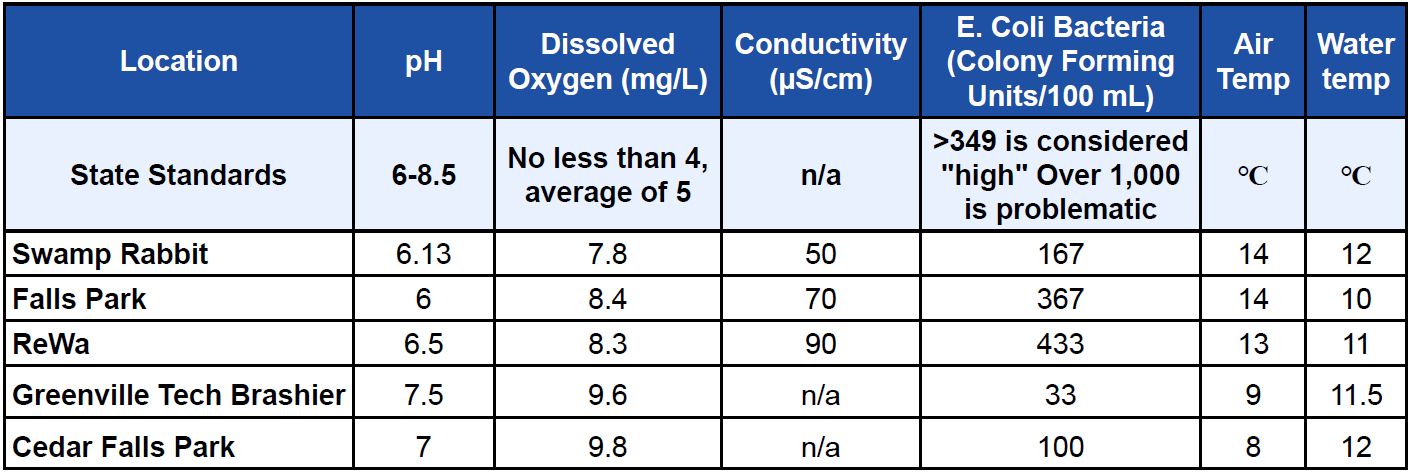|
The pH results for December were the same as or consistent with last month's findings for the sites in the Greenville area, showing small changes, if any.
The air and water temperatures during December’s sampling events were much more characteristic of normal seasonal temperatures compared to last month’s uncharacteristically warm temperatures on the Greenville Team’s sampling date (air temperature of 24℃ or about 75˚F at the Swamp Rabbit Café Site!). The average air temperature during our December sampling dates was 11.6℃ with a range of 8 – 4℃. The average water temperature was 11.3℃, with temperatures ranging from 10 – 12℃.
December’s dissolved oxygen (DO) sampling results correlate with the lower air and water temperatures and all sites returned to a standard seasonal range, with results between 7.8 – 9.8 mg/L. The sites in the Greenville area showed the largest increases, like the 2.8 mg/L jump to 8.4 mg/L at Falls Park, most likely because of the drastically cooler water temperature of only 10℃, which is 8 degrees cooler than November’s result. ReWa and Swamp Rabbit Café both also experienced increases in DO and had results of 8.3 mg/L and 7.8 mg/L, respectively. The Simpsonville sites both showed very small decreases in their DO levels (decreases of only 0.2 and 0.3 mg/L) and their water temperatures stayed fairly consistent with last month’s reading. Greenville Tech Brashier’s water temperature decreased by only 1.5℃ and Cedar alls Park’s water temperature actually increased by 2℃. These small variations are typical and not cause for concern. Overall, the DO results were typical for this time of year and reflect seasonal changes that further confirm the association between DO and water temperature: the colder the water, the higher the water’s capacity for dissolved oxygen!
December’s E. coli bacteria results at the Greenville monitoring locations were either the same or showed small increases from November’s results. This can best be attributed to the high rainfall levels in the days prior to our sampling events. While Greenville had only received approximately 0.35 inches of rain in the 24 hours prior to our sampling event on December 7, the water levels were still quite high and the water was turbid (slightly mucky, not completely clear), and we can infer that the slight increases in the E. coli levels at ReWa and Falls Park are due to this fast-moving, turbid water. The levels for these sites were still relatively low at only 367 cfu/100ml at Falls Park, which is below the “high” threshold of 349 cfu/100mL, and 433 cfu/100mL at ReWa, which is still well below the “problematic” cap of 1,000 cfu/100mL. E. coli levels at Cedar Falls Park and Greenville Tech Brashier were very low, with a result of only 33 cfu/100mL at Greenville Tech Brashier! The Simpsonville sites typically have lower bacteria levels due to their ocation in a less urbanized environment, which protects the river from high volumes of runoff like what is seen in the downtown Greenville area. Overall, the E. coli levels for December were typical for this time of year, and even slightly lower than expected after the amount of rainfall received so far this month.
This month's results and the SC state standards are included for comparison below. All results were within state standards.

- pH is a way of measuring the H+ ions in a water sample, or if the sample is acidic or basic. pH is influenced by the concentration of acids in rain, and the types of soils and bedrock present in the watershed. Ideally, rivers will have a neutral pH, or a value of 7.
- The available dissolved oxygen (DO) in a water sample is important for fish health and life within a body of water. DO can increase in lower temperatures, turbulence in the water, photosynthesis in the stream, and diffusion from the atmosphere. DO can decrease in higher temperatures, in slow-moving and deep water, and in the presence of decaying organic matter.
- Conductivity is the ability of the water to pass an electric charge and shows the presence of ions in the water, such as salt, nitrate, phosphate, and many others. The bedrock in the watershed can also affect conductivity
- Bacteria counts are found by incubating a water sample that was placed on a medium, then counting the number of coliform forming units. These values are higher in areas where animals are present so always remember to pick up after your pets and don't feed the geese in the park!
|
|
Sign up to join the FoRR monitoring team HERE!
Find an SC Adopt-a-Stream event near you to become certified HERE!
|
The FoRR Monitoring Team uses SC Adopt-a-Stream techniques and has its own monitoring kits, thanks to Ivy Salon and The Greenville Zoo Conservation Fund.
|
|
|
|
|